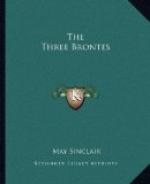So much Mr. Malham-Dembleby assumes in the interests of psychology. But it is not from crude psychological arguments that he forges his tremendous Key. It is from the internal evidence of the works, supported by much “sensational” matter from the outside.
By way of internal evidence then, we have first the sensational discovery of a work, Gleanings in Craven, or The Tourists’ Guide, by “one Frederic Montagu”, published at Skipton-in-Craven in 1838, which work the author of Wuthering Heights and Jane Eyre must have read and drawn upon for many things, names (including her own pseudonym of Currer Bell), descriptions of scenery, local legends, as of that fairy Jannet, Queen of the Malhamdale Elves, who haunted the sources of the Aire and suggested Rochester’s Queen of Elves, his fairy, Janet Eyre. Parallel passages are given showing a certain correspondence between Montagu’s traveller’s tale and the opening scene of Wuthering Heights. Montagu goes on horseback to a solitary house, like Lockwood, and, like Lockwood, is shown to bed, dreams, and is awakened by a white-faced apparition (his hostess, not his host), who holds a lighted candle, like Heathcliff, and whose features, like Heathcliff’s, are convulsed with diabolical rage, and so on. Mr. Malham-Dembleby, in a third parallel column, uses the same phrases to describe Jane Eyre’s arrival at Rochester’s house, her dreams, and the appearance of Rochester’s mad wife at her bedside; his contention being that the two scenes are written by the same hand.
All this is very curious and interesting; so far, however, Mr. Malham-Dembleby’s sensational evidence does no more for us than suggest that Charlotte and Emily may very likely have read Montagu’s book.
But the plot thickens. Mr. Malham-Dembleby first prints parallel passages from Montagu’s book and Wuthering Heights and Jane Eyre, then, extensively, scene after scene from Jane Eyre and Wuthering Heights.
Some of these coincidences seem on the first blush of it remarkable, for instance, the child-phantom which appears both to Jane Eyre and to Nelly Dean in Wuthering Heights; or the rainy day and the fireside scene, which occur in the third chapter of Wuthering Heights and the opening chapter of Jane Eyre. Others again, such as the parallel between the return of Heathcliff to Catherine and that of Jane to Rochester, will not bear examination for a moment. Of this and most of Mr. Malham-Dembleby’s parallels it may be said that they only maintain their startling character by the process of tearing words from their sentences, sentences from their contexts, contexts from their scenes, and scenes from the living body of each book. Apparently to Mr. Malham-Dembleby, a book, at any rate a Bronte book, is not a living body; each is a box of German bricks, and he takes all the boxes and tumbles them out on the floor together and rearranges them so as to show that, after all,




